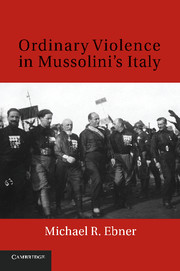Book contents
- Frontmatter
- Dedication
- Contents
- Tables and Figures
- Acknowledgments
- Common Abbreviations in Text and Notes
- Introduction: The Fascist Archipelago
- 1 Squad Violence
- 2 Institutions of Fascist Violence
- 3 Breaking the Anti-Fascists, 1926-1934
- 4 The Archipelago
- 5 The Politics of Pardons
- 6 Everyday Political Crime
- 7 Ordinary Fascist Violence
- 8 The Politics of Everyday Life
- Conclusion
- Bibliography
- Index
3 - Breaking the Anti-Fascists, 1926-1934
Published online by Cambridge University Press: 05 July 2014
- Frontmatter
- Dedication
- Contents
- Tables and Figures
- Acknowledgments
- Common Abbreviations in Text and Notes
- Introduction: The Fascist Archipelago
- 1 Squad Violence
- 2 Institutions of Fascist Violence
- 3 Breaking the Anti-Fascists, 1926-1934
- 4 The Archipelago
- 5 The Politics of Pardons
- 6 Everyday Political Crime
- 7 Ordinary Fascist Violence
- 8 The Politics of Everyday Life
- Conclusion
- Bibliography
- Index
Summary
Always terror, fear. Either they took papa away or they went after the family. There you go: it was terror.
A woman from San Lorenzo, a working-class district in Rome, recalls life under FascismThey beat up Mario, they put Oreste in jail, they threw my brother out of his job. It is a leitmotiv. No one has ever forgotten.
Igor Markevitch on the Tuscan peasantryFor Italians who had been victimized by squad violence, the Fascist police state presented a new, even more potent form of terror. Viewed from below, all state institutions now appeared to rest in the hands of Mussolini and the Fascists. Even at the local level, Black Shirts held considerable sway over how the state punished anti-Fascists. Although illegal violence had diminished by 1926, systematic state violence in some ways functioned more efficiently. Individual anti-Fascists and recalcitrant working-class communities who had successfully fended off Fascist attacks in the past now had to contend with the police, carabinieri, courts, prisons, and other punitive institutions. The hostile practices of these and other state agencies – such as labor syndicates and welfare offices – ultimately overwhelmed Mussolini's opponents and the communities in which they operated. Eventually, the forces of anti-Fascism within Italy were broken. Italians who possessed the resolve to fight on usually did so alone, most often behind prison bars or inside of island confino colonies.
- Type
- Chapter
- Information
- Ordinary Violence in Mussolini's Italy , pp. 72 - 102Publisher: Cambridge University PressPrint publication year: 2010

